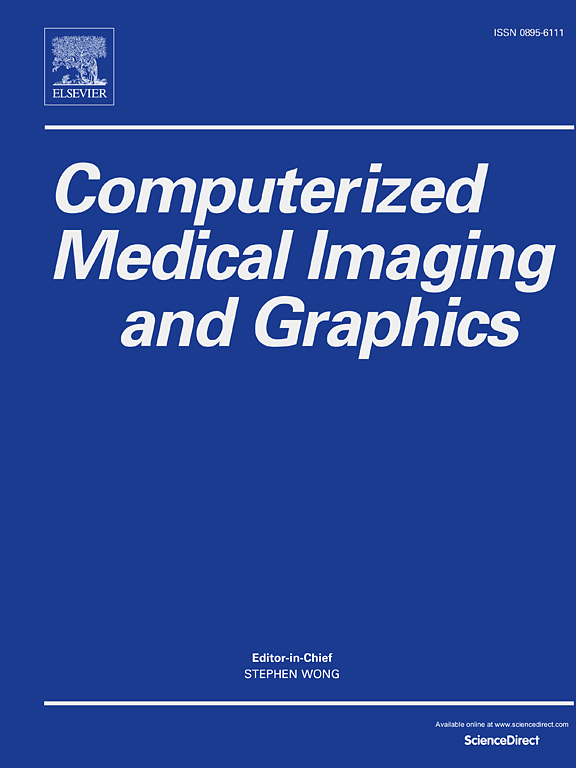NURBS curve shape prior-guided multiscale attention network for automatic segmentation of the inferior alveolar nerve
IF 5.4
2区 医学
Q1 ENGINEERING, BIOMEDICAL
Computerized Medical Imaging and Graphics
Pub Date : 2025-01-07
DOI:10.1016/j.compmedimag.2024.102485
引用次数: 0
Abstract
Accurate segmentation of the inferior alveolar nerve (IAN) within Cone-Beam Computed Tomography (CBCT) images is critical for the precise planning of oral and maxillofacial surgeries, especially to avoid IAN damage. Existing methods often fail due to the low contrast of the IAN and the presence of artifacts, which can cause segmentation discontinuities. To address these challenges, this paper proposes a novel approach that employs Non-Uniform Rational B-Spline (NURBS) curve shape priors into a multiscale attention network for the automatic segmentation of the IAN. Firstly, an automatic method for generating non-uniform rational B-spline (NURBS) shape prior is proposed and introduced into the segmentation network, which significantly enhancing the continuity and accuracy of IAN segmentation. Then a multiscale attention segmentation network, incorporating a dilation selective attention module is developed, to improve the network’s feature extraction capacity. The proposed approach is validated on both in-house and public datasets, showcasing superior performance compared to established benchmarks, achieving 80.29±11.04% dice coefficient (Dice) and 68.14±12.06% intersection of union (IoU), the 95% Hausdorff distance (95HD) reaches 1.61±6.14 mm and mean surface distance (MSD) reaches 0.64±2.16 mm on private dataset. On public dataset, the Dice reaches 80.69±4.93%, IoU reaches 67.86±6.73%, 95HD reaches 1.04±0.95 mm, and MSD reaches 0.42±0.34 mm. Compared to state-of-the-art networks, the proposed approach out-performs in both voxel accuracy and surface distance. It offers significant potential to improve doctors’ efficiency in segmentation tasks and holds promise for applications in dental surgery planning. The source codes are available at https://github.com/SJTUjsl/NURBS_IAN.git.
NURBS曲线形状先验引导多尺度注意网络下牙槽神经自动分割。
圆锥束ct (Cone-Beam Computed Tomography, CBCT)图像中准确分割下牙槽神经(IAN)对于口腔颌面外科手术的精确规划,尤其是避免下颌牙槽神经损伤至关重要。现有的方法往往失败,由于低对比度的IAN和存在的伪影,这可能会导致分割不连续。为了解决这些问题,本文提出了一种新的方法,将非均匀有理b样条(NURBS)曲线形状先验引入到多尺度注意力网络中,用于人工神经网络的自动分割。首先,提出了一种非均匀有理b样条(NURBS)形状先验的自动生成方法,并将其引入到分割网络中,显著提高了IAN分割的连续性和准确性;为了提高网络的特征提取能力,设计了一种包含扩张选择性注意模块的多尺度注意力分割网络。在内部和公共数据集上验证了该方法,与现有基准相比,该方法的性能优越,在私有数据集上实现了80.29±11.04%的骰子系数(dice)和68.14±12.06%的联合交叉点(IoU), 95% Hausdorff距离(95HD)达到1.61±6.14 mm,平均表面距离(MSD)达到0.64±2.16 mm。在公开数据集上,Dice达到80.69±4.93%,IoU达到67.86±6.73%,95HD达到1.04±0.95 mm, MSD达到0.42±0.34 mm。与最先进的网络相比,该方法在体素精度和表面距离方面都优于最先进的网络。它为提高医生在分割任务中的效率提供了巨大的潜力,并有望在牙科手术计划中应用。源代码可从https://github.com/SJTUjsl/NURBS_IAN.git获得。
本文章由计算机程序翻译,如有差异,请以英文原文为准。
求助全文
约1分钟内获得全文
求助全文
来源期刊
CiteScore
10.70
自引率
3.50%
发文量
71
审稿时长
26 days
期刊介绍:
The purpose of the journal Computerized Medical Imaging and Graphics is to act as a source for the exchange of research results concerning algorithmic advances, development, and application of digital imaging in disease detection, diagnosis, intervention, prevention, precision medicine, and population health. Included in the journal will be articles on novel computerized imaging or visualization techniques, including artificial intelligence and machine learning, augmented reality for surgical planning and guidance, big biomedical data visualization, computer-aided diagnosis, computerized-robotic surgery, image-guided therapy, imaging scanning and reconstruction, mobile and tele-imaging, radiomics, and imaging integration and modeling with other information relevant to digital health. The types of biomedical imaging include: magnetic resonance, computed tomography, ultrasound, nuclear medicine, X-ray, microwave, optical and multi-photon microscopy, video and sensory imaging, and the convergence of biomedical images with other non-imaging datasets.

 求助内容:
求助内容: 应助结果提醒方式:
应助结果提醒方式:


